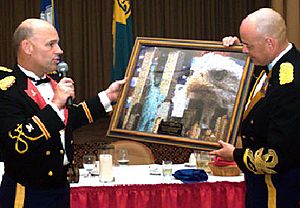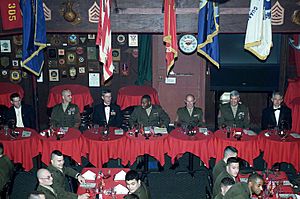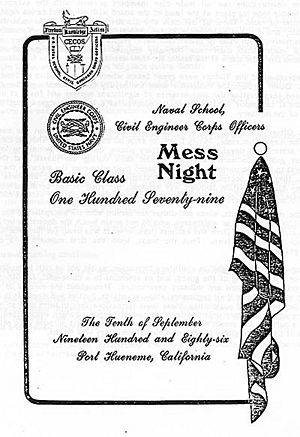Dining in facts for kids

Dining in is a special formal dinner held by members of the military. It's a tradition for a company or other unit to gather for a meal, drinks, and other activities. The main goal is to build camaraderie (friendship) and esprit de corps (team spirit) among the soldiers, sailors, or airmen.
In the United States Army, United States Coast Guard, and United States Air Force, this event is called a dining in. The United States Navy and United States Marine Corps call it a mess night. Other names include regimental dinner or guest night.
A dining in is usually for all members of a military unit. Sometimes, special mess nights are only for officers or only for enlisted members. The unit's chaplain (a religious leader) might be invited to give a prayer. Only members of the unit attend, along with any special guest(s) of honor. There's also a dining-out, which is a similar formal dinner. Spouses and other guests can attend a dining-out. It follows many of the same rules but is often less strict with military traditions to make it more welcoming for civilian guests.
Except for the annual celebration of the Marine Corps Birthday, no social function associated with the smaller of America's naval services is more enjoyed, admired and imitated than the mess night.
Contents
History of Military Dinners
The idea of formal military dinners likely started in 16th-century England. It was common in monasteries and universities back then. Some records suggest that militaries have had formal dinners for a very long time, even as far back as the Roman Legions. The Vikings also held special ceremonies to celebrate battles and heroes.
In the 18th century, the British Army made formal dining a regular part of their regimental system. They created customs and rules for these dinners, which became known as the "Queen's Regulations". The mess night became a strong tradition in all British regiments. Americans adopted many traditions from the British military. They held mess nights in the 18th and 19th centuries, but the tradition became less common after the American Civil War.
The tradition of dining in stopped for a short time in the Navy and Marine Corps. This happened when Navy Secretary Josephus Daniels banned alcoholic drinks. However, the tradition was soon brought back. During World War II, the custom was revived in the U.S. military. It started with the US Army Air Forces 8th Air Force, which was based in Britain. American officers were invited to British military mess nights and then had to host their own in return.
British Dining Traditions
Formal Gatherings
In the British military, a formal function is an event where all mess members might be required to attend. Service personnel are considered to be on official duty during these events.
Loyal Toast
During a formal dinner, port decanters are placed on the table. The President and Vice President of the mess remove the stoppers at the same time. They then pass the decanters around the table, usually to the left. Stewards follow with water for anyone who doesn't want port. After everyone's glass is filled, the President asks the Vice President to propose the Loyal Toast. This toast is usually to the King.
Members of the Army and Royal Air Force (RAF) stand for the Loyal Toast. However, those in the Royal Navy (RN) remain seated. When passing the port, RN Senior Rates traditionally keep the decanter on the table. They tip it to fill a glass held below the table edge, then slide it to the next person. In the RAF, the decanter is passed hand-to-hand without touching the table. The Army's tradition depends on the specific regiment.
Royal Navy officers have a special privilege: they can remain seated when toasting the Sovereign (the King or Queen). A popular story says this privilege started with King Charles II. He supposedly bumped his head on a low ceiling on his ship, Royal Charles, when he stood up to toast himself. He then declared that naval officers would never have to stand again to toast a British ruler. In 1964, Queen Elizabeth II gave this same privilege to the Royal Marines to celebrate their 300th anniversary.
The custom of "dining in" to welcome new officers and "dining out" to say goodbye to retiring officers began with the British. While some countries, like the United States, have stopped this specific practice, it is still done by the Royal Navy.
Toasts at Sea
For ships at sea, there are traditional toasts after dinner for each day of the week. For example:
- Sunday: "Absent friends"
- Monday: "Our ship at sea"
- Tuesday: "Our sailors"
- Wednesday: "Ourselves"
- Thursday: "A bloody war or a sickly season"
- Friday: "A willing foe and sea room"
- Saturday: "Our families"
Trafalgar Night
Trafalgar Night Mess Dinners have a slightly different routine. Before the main course, a large piece of beef is paraded around the table with a drummer. Similarly, before dessert, models of "Ships of the Line" (old warships) are paraded. The toasts for Trafalgar Night are:
- His Majesty the King.
- The immortal memory of Admiral/Lord Nelson and his comrades.
- Our distinguished guests (if they are present).
Royal Air Force
The Royal Air Force (RAF) adopted many mess traditions from the British Army. This is because their main predecessor, the Royal Flying Corps, was part of the Army. These customs were later passed on to the US Army Air Forces during World War II. This happened as British and American crews served closely together.
US Dining Traditions
Parts of the dining in event can be very funny, while other parts remain serious. Knowing what is appropriate at any time is important.
The dining in follows specific rules. After a short time for drinks (about 30 to 45 minutes), the officer in charge, called the "President of the Mess," announces, "Please be seated." Everyone then moves to the dining area and sits down.
After tasting the main dish (usually beef), the President declares it "tasty and fit for human consumption." Then, the meal is served to everyone. After dessert, the President invites the chief steward to bring out drinks for toasting. After the toasts are finished, people can propose "fines" for rule violations. The President and the guest of honor may also speak. After this, the event often becomes a more relaxed social time, ending with final honors.
Formal Toasts
Formal toasts are a very important part of a dining in. A junior officer, called "Mr/Madam Vice," proposes the first toast to the guests. The guests remain seated for this. After that, different people will offer toasts. These toasts are usually to the commander in chief (like the President), to the leaders of visiting countries, to their branch of service, to their units, and to military members who have died.
| Recipient | Toast | Response ! |
|---|---|---|
| King | "To His Majesty, the King of ___________." | "His Majesty, the King of ___________." |
| Queen | "To Her Majesty, the Queen of___________." | "Her Majesty, the Queen of ___________." |
| President | "To His Excellency, the President of ___________." | "His Excellency, the President of ___________." |
| Prime Minister | "To His Excellency, the Prime Minister of ___________." | "His Excellency, the Prime Minister of ___________." |
| Governor | "To His Excellency, the Governor of ___________." | "His Excellency, the Governor of ___________." |
| Commander in Chief | "Ladies and Gentlemen, the Commander-in-Chief of the ___________." | "The Commander-in Chief of ___________," |
| Branch of Service | "To the ___________." | "United States Army" "United States Marine Corps" "United States Navy" "United States Air Force" "United States Coast Guard" |
In the United States, the Commander-in-Chief and the President are the same person.
The last and most serious toast is always to fallen comrades. This tribute often includes a special table setting to remember military members who were killed, captured, or went missing in action.
Some unusual ways of toasting are common in U.S. and Canadian traditions. For example, in the Toronto Scottish Regiment, a toast to the regiment's colonel-in-chief (who is King Charles III as of 2024) is done while standing with one foot on the chair and one foot on the dining table. The person faces a portrait of the King and drinks after a bagpiper plays. This is also a frequent way of toasting in the United States Marine Corps.
Fun Rules and Traditions
Breaking the formal rules of the dining in can lead to "punishments," usually in the form of "fines." These fines are often light-hearted and meant to add to the fun. Here are some examples of things that might be considered "Violations of the Mess":
- Arriving late to the event.
- Smoking at the table before it's allowed.
- Wearing your uniform incorrectly.
- Making loud or rude comments in a foreign language.
- Using bad language.
- Talking about sensitive topics like politics or religion.
- Toasting with an empty glass.
- Leaving the dining room without permission from the President of the Mess.
- Bringing drinks into the dining area before dinner is over.
- Arguing about any penalties or fines given.
- Drawing a sword unless it's part of a ceremony.
At some mess nights, people who break the rules might have to drink from a "grog bowl" in front of everyone. The grog is a special mixed drink. Sometimes, it might even have funny things floating in it, like meatballs or candy, to make it less appealing. The tradition of drinking grog started with the British Navy. In modern times, grog can be made with or without alcohol. The non-alcoholic version might include things like hot sauce to make it taste unusual.
Besides visiting the grog bowl or paying fines, rule-breakers might be asked to sing songs, tell jokes, do pushups, or perform small tasks to entertain the group. When someone is caught breaking a rule, they usually get a chance to explain themselves. However, this rarely gets them out of the "punishment" and often leads to more fun consequences!
Traditionally, all the money collected from fines throughout the night is given to the stewards (servers) as a thank you for their hard work. Sometimes, the fines are used to pay for drinks or even to help fund a military ball.
Members of the mess might also playfully tease each other. Some people even try to get "fined" on purpose. They might wear obvious uniform mistakes, like crowns, eye-patches, or bowties of the wrong color. Others might try to trick their friends into getting fined by leaving "evidence" near them. So, you have to be careful not to be the target of a joke!
Navy and Marine traditions also include a rule that no one can leave the hall to use the restroom without permission. This is until "Mr. Vice" suggests that everyone "shed a tear for Lord Admiral Nelson." This is a reference to the story that Nelson's body was preserved in a barrel of brandy after he died at the Battle of Trafalgar.
Most mess nights feature military music and marches. Sometimes, there are live bands, or recorded music is played. Depending on how formal the ceremony is, diners might even march to their seats.
Recently, Marines have created a version of the mess night for "field environments." Instead of formal uniforms, they wear their camouflage uniforms and combat gear (including facepaint). They use canteen cups instead of fancy glasses and hold the event in tents. Even in this setting, they keep the formal nature of the ceremony.
See also
- Mess
- Mess dress
- Missing man table
- Wardroom



